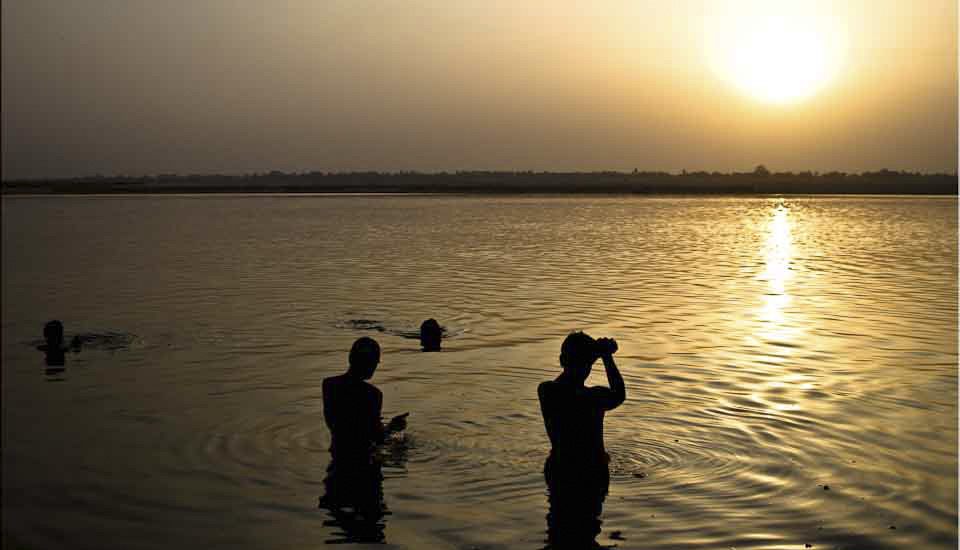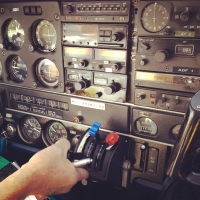.jpg)
Old Auntie Smoking
It may be full daylight outside, but it is black and smoky inside a traditional Himba hut.
It is dark inside a wattle and daub Himba wattle and daub hut.
As well as being dark, the huts are likely to be noisy with chatter, packed with bodies, and smoky from the fireplace, pipe tobacco, and incense.
The huts are built from mopane wood – a local termite-resistant hardwood – plastered with a mixture of clay and animal dung. An open fireplace sits on the packed-dirt floor in the centre, and heavy wooden supports rise up to the domed roof. With no windows or chimney, the smoke and heat hang heavy in the air. The only light enters through the odd cracks in the plaster and through the single doorway.
The Himba are a small tribe (about 50,000) of semi-nomadic pastoralists eking a living out of the hot, dry landscape either side of the Kunene River, which runs between Namibia and Angola. Although they are not isolated from urban centres and other tribes in the Kunene Region, the Himba have managed to maintain their unique culture; little has changed since the 16th century.
Himba are immediately recognisable by their distinctive hairstyles (see: Mother and Child; Women of the Himba; Himba Model Shoot), which are determined by their age, gender and marital status. Although men often dress in western clothing, the women and girls are more commonly seen in their age-old costume of soft cow-hide skirts and head-dresses; metal anklets, ornaments and belts; and orange-tinted body butter.
Maintaining their elaborate hair-styles and full body paint takes the women hours every day, so it is no surprise that they might perform their ablutions as part of a social gathering, complete with pipe smoke, gossip, and laughter. Very early one November morning, my cameras and I – and a male colleague – were lucky enough to be invited into a small hut in Otjomazeva Village in the Kunene region of Northern Namibia. Our photo-tour co-ordinator, Photographer Ben McRae had done all the necessary ground-work before our arrival.
The women in the hut seemed to forget our presence: they continued chatting and performing their morning regimen, while we sat on a cowhide mats in the crowded space either side of the front entry.
.jpg)
Inside the Hut
It is dark and crowded inside the hut as the women complete their morning beauty ritual.
.jpg)
Young Woman
This young woman is only recently married – which is one reason she is not wearing an Erembe – the Himba crown crafted from the skin of a sheep or goat’s head.

Smoking
Himba women don’t use water to wash – there is just too little of it in this arid environment. Instead, they burn aromatic plants and resins and use the smoke created to perfume and clean themselves and their clothing.

Hot Coals for Smoking

Mother and Child
The Himba are a proud and beautiful people.

Feet-Ash-and-Leggings
Married women wear beaded anklets which are reputed to protect them against snake bite.

Butterfat for Otjize Paste
The body-butter Himba use to keep their skin fresh and protected from insects and sunburn, starts with butterfat or vaseline.

Adding Herbs to the Otjize
The women add the resin of the omuzumba shrub and a variety of leaves and herbs to their mixture …

Otjize
… which results in a beautifully scented paste.

Adding Ochre
The final and most important ingredient in the otjize, the body-butter mix, is ground ochre which gives the paste – and everything it is rubbed onto – its rich warm colour.

Oiling with Otjize
The colour of blood and the earth, red is considered beautiful and a symbol of life.

Cleaning her Belt
The women’s jewellery, including the heavy belts and necklaces woven with metal wire, are cleaned and re-oiled daily.

Oiling the Erembe Headdress
A lot of time is spent rubbing paste into the leather headdress …

Oiling the Ohumba Necklace
… and the metal jewellery. Married women wear a heavy necklace made of iron and brass beads.

Mother and Child
As the young mother speaks, we can see the gap where her top incisors have been filed. Both men and women have the bottom incisors knocked out and the uppers filed in an upside-down v during a ceremony around puberty. This is supposed to attract the protection of the ancestors.

The Pipe
The older women enjoy a quiet pipe before passing it around.

Old Auntie Smoking

Old Auntie
Freshly smoked and oiled, an old Auntie sits quietly under her heavy rug. Nights are cold here in autumn – although I find it quite hot in the hut.

That Toothless Smile!
The Himba habit of dental destruction leads to some interesting gaps in the old women’s smiles.

Oiling the Baby
From the time they are born, females wear the otjize paste.

Mother and Child

Girl-Child
After being re-covered in Otjize, this toddler escaped her mother to come and visit me.

Those eyes!
This young newlywed – beautiful in her own right – clearly looked up to the young mother in the hut; I think she was in awe of her, and of her motherhood.
It was a privilege sharing time with these extraordinary people –
And it sure made me appreciate the running water back at my rustic camp-site!
Until next time,
Happy travels!
Photos: 17August2015



.jpg)




























.jpg)


Beautiful photos
Thanks! x
Another excellent series Ursula. You mention how dark the hut interior was, were you using available light only or did you use some flash as well? It’s not really obvious looking at the images.
Hi Kevin,
Thanks for dropping in. 😀 No flash on these – just ISO cranked as far it will go, then a LOT of noise reduction in Lightroom.
Beautiful photos, fabulous wandering!
Thanks, Leslie. So nice to “see” you on line. 😀
Gorgeous photos Ursula.
Thanks so much, Trish! 😀
[…] A tall, good-looking people, the Hamar are possibly the most recognisable of the Omotic tribes. Men, women, and children generally sport multiple strands of colourful beads. The men often wear a clay cap, decorated with feathers. Like other groups in the region, they can be seen carrying or using their small wooden stools/pillows. Women have elaborately decorated goatskin bibs, which – these days – are reserved for special occasions. They layer themselves in beaded belts, bracelets and necklaces, as well as wearing copper or metal necklaces that signify their marital status (e.g.: first wife, second wife, etc.). Most strikingly, they coat their hair in a clay and butter mixture – reminiscent of the Himba people of distant Namibia (e.g.: The Morning Routine). […]